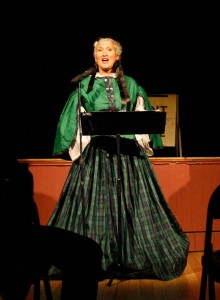
Linda Radtke, accompanied by pianist Arthur Zorn, perform Wednesday evening at the St. Albans Historical Museum.
ST. ALBANS — There’s nothing like a little music to transport people back to 1864.
The Vermont Civil War Songbook, performed by singer Linda Radtke and piano accompanist Arthur Zorn and put on by the Vermont Humanities Council, drew about 50 people to the St. Albans Historical Society Wednesday evening. The event was the first one of many during this week’s St. Albans Raid 150th Anniversary Commemoration, and it was full of 19th century songs, soldiers’ and their families’ letters, and the sense of both excitement and mourning for those who lived through the Civil War.
“If you were going to school here during the [St. Albans] Raid, you would have been ushered into the stairway,” said Radtke, referring to the historical museum’s former use as the St. Albans Academy from which some students actually snuck a peek at the ruckus in the park below.
Radtke, a 61-year-old retired teacher and performer from Middlesex, told her audience that all of the songs she sang last night were dedicated to those St. Albans citizens who were held hostage and injured or killed during the Raid, and also to the numerous St. Albans boys who went to fight for the Union and never made it home.
Radtke added that many St. Albans soldiers are buried in the South having been killed in battle, succumbing to disease, or dying in Andersonville Prison in Georgia.
Singing songs about training for battle, lost loved ones, and wanting to “sleep in the pines of Vermont,” Radtke, dressed in an 1859 dress with a hoop skirt and lace bonnet, explained that there’s a change of tone in the songs written during the Civil War.
“At the beginning, they’re all full of hope,” she said. Radtke went on to say that hope and adventure turns to heartbreak, then to anger, and lastly to forgetting. When Radtke performed accompanied by Zorn, many of the songs had a march-like, steady tempo, interspersed sometimes with narration, with light humor, or with poignant messages about life, love and loss.
Radtke also read some letters written by local residents during the Civil War. These included some from young St. Albans soldiers about their experience on the battlefields or in camps, some from family members to their boys, and one from Ann Eliza Smith to her husband and Vermont’s governor at the time, John Gregory Smith.
Throughout Radtke and Zorn’s performance, there was a keen sense the events that took place both in St. Albans and across the country during the Civil War were still present and quite sad.
In addition to respect and emotion, Radtke also brings to her performances quite a bit of research. In an interview with the Messenger Wednesday, she said she has spent a lot of time going through 19th century sheet music and letters at the Vermont Historical Society in Barre.
“In the beginning, it was just trying to look through the [Vermont Historical Society] and discover things,” Radtke said. “I decided to take a look at what Vermonters were singing. People don’t hear these songs anymore.”
Radtke has been performing with Zorn through the Vermont Humanities Council about once a month for the past four years, though she has been traveling and singing Civil War songs for two decades or so. She has performed in St. Albans twice before.
“I’m a singer and I’ve always loved to sing,” Radtke said. “This is a great project for me.”
In addition to her performances, Radtke is a founding member of the professional vocal ensemble Counterpoint, she has brought vocal music to about 150 Vermont schools through the quartet Ah!Cappella, and she also produces VPR Choral Hour every Sunday morning for Vermont Public Radio Classical.
When asked why she chooses to perform sheet music songs written long ago, Radtke said she wants to unite communities with their history – Radtke changes the songs and letters she sings and reads to match the area she’s performing in.
“We don’t do these anymore,” Radtke said. “We don’t create songs to commemorate events in our community. They’re gems.”
She added, “For me, it’s such an insight – it’s the real people. It’s really important for people to realize how to preserve these. To get people to look at their own local history.”
By ELODIE REED
St. Albans Messenger Staff Writer



